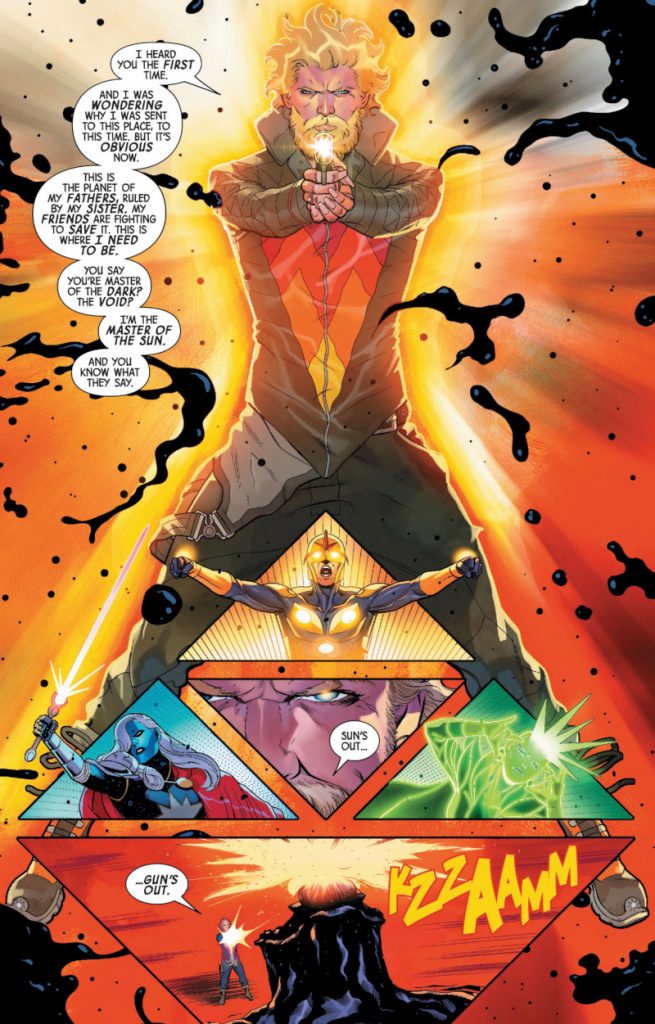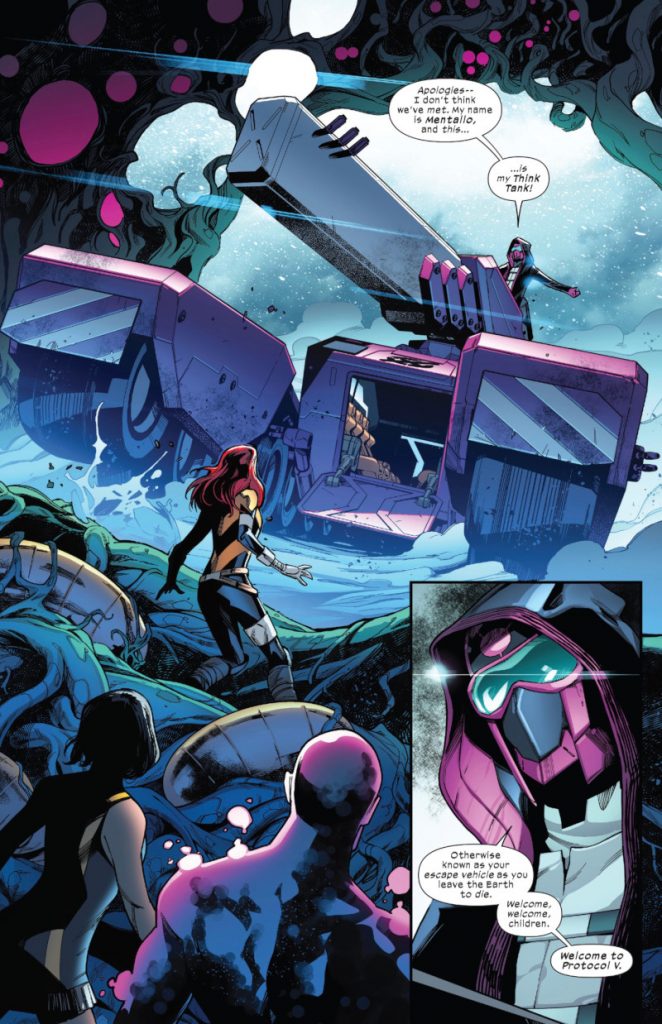The King of the Tie-In
Al Ewing is the best in the biz at event tie-ins. Let’s investigate the keys to his kingdom through a quartet of recent examples.
While the basic idea of superhero comics is inherently a mixed bag – there’s a whole lot of good, bad and in-between amongst the lot of them – there’s no more unpredictable iteration of that form than the event tie-in. Occasionally beloved, often hated, and rarely something readers are clamoring for, these stories can be a hindrance to existing narratives at the best of times and a jumping off point in the worst of them. That makes them a tough line to walk, especially if the event itself is one that fails to generate enthusiasm. In that case, these tie-ins don’t act like the rising tides they’re designed to be, but anchors instead.
That was the situation I found myself in with the current Marvel event, King in Black. I’m not reading it, so I cannot speak to its quality, but it just didn’t interest me. So a title tying into that storyline immediately made purchase of it less likely, simply because of area of effect. The ones that made it through had to be solid gold faves with an expectation for making it work. While this list isn’t exhaustive, there were three main titles tying in that I knew would come home with me, and those were a related Immortal Hulk one-shot, two issues of S.W.O.R.D., and a Guardians of the Galaxy entry. 8 What did those three have in common?
They were all written by Al Ewing.
Now, it’s hardly a hot take to suggest Ewing is good at his job. I’d wager that if you polled every superhero-leaning comics critic, Rotten Tomatoes-style, Ewing would have the highest “fresh” rating amongst current writers because both the ceiling and the floor of his work is enormously high. And there are plenty of reasons for his greatness, but one unique strength he has is a rare adeptness at the tie-in form. Now, here’s a moderate hot take: I’d argue that Al Ewing might be the best tie-in writer we’ve ever had in superhero comics, although I’m likely to be annoyed with myself because I forgot someone. 9
Part of that greatness comes from Ewing putting in the work to figure this form out. When I was working on my Secret Wars oral history, one thing I was surprised to learn came from Marvel editor Nick Lowe, who told me that tying into events – much to the surprise of many readers! – is voluntary, besides in some very specific scenarios. You can opt-in, or you can opt-out. A lot of writers and editors choose the latter, as tie-ins can disrupt narrative flow and be a hindrance on the fate of a book rather than an aid. Ewing, on the other hand, used to lean into the form, as he shared with me in the interviews from the same piece.
“My philosophy in those days, that’s changed since, was to take advantage of tie-ins whenever the opportunity arose, so it wasn’t as if I was being forced into something I wouldn’t have done anyway,” Ewing said.
I’m sure Ewing had his struggles in making it work in the beginning, but the thing is, he put in the reps. And by practicing the form he figured out how to ace all these tests. Those four recent King in Black tie-ins are perfect evidence of that. They weren’t just great tie-ins, but phenomenal comics unto themselves. That’s an important distinction. But instead of writing more about why I think Ewing is the best in the biz, we’re instead going to try to boil those individual issues down to eight commonalities, and how that octet presents a playbook to making this form work, no matter what.
Quick note: if you have not read these four issues yet and you’re concerned about spoilers, you might want to consider reading them first.

1. Don’t Break Your Flow
When Ewing was sharing his perspective on tie-ins, that quote above had another line at its conclusion which underlined a core philosophy to his approach with these stories.
“And there being different ways you could do the tying in made it easy to tell the story you wanted to tell anyway,” the writer said.
The ending there is essential: it “made it easy to tell the story you wanted to tell anyway.” There are a lot of different flavors of tie-ins, but there’s one clear dividing line between the ineffective ones and those that make it work, and that’s that very idea. You can either fit your story in around the event-related content, or you can do the opposite, and just make what’s happening in the event something that’s happening as your core story beats are playing out.
Guardians of the Galaxy #10 is a perfect example of this. The preceding issue reintroduced Peter Quill into the Marvel universe after centuries in another realm, during which he fully unlocked the powers he was originally given as Star-Lord by the Master of the Sun. #9 ended with Quill on a planet of unknown identity with Rocket Raccoon and Nova rushing up to him, shocked that he’s still alive.
And the eleventh issue perfectly worked off the conclusions of both #8 – in which a diplomatic conference/murder mystery ended with the revelation that King in Black’s villain Knull was eating planets 10 – and #9, with the Guardians’ efforts to save the planet of Spartax being aided by the newly ascendant Quill, whose Master of the Sun-fueled power set worked as a perfect counter to Knull’s Master of the Dark ways. Ewing didn’t make this tie-in about King in Black; he used King in Black as a showcase to the important changes he just brought to his cast.
It’s all about not breaking your flow just to connect to a larger story, and Guardians #10 is a textbook example of how that’s done.
Plus, it allowed Ewing to use the phrase, “Sun’s out, gun’s out” in the best possible way. That’s a significant win.

2. Make it ABOUT something else
Tying into an event can be a curse, but it also can be an opportunity to showcase something you want to get to anyways. Three of these tie-ins that Ewing wrote are phenomenal examples of that, but let’s focus on the second S.W.O.R.D. issue here. Issue #2 was largely the organization trying to figure out what was going on and how they can ensure Krakoa moves forward without any catastrophic problems in the face of the Knull of it all. Within it, it introduced an answer to a crucial question: what happens with The Five – the quintet whose powers unite to resurrect deceased mutants – when one of 616’s famed nightmare scenarios rears its ugly head?
Protocol V!
This cleverly named procedure revealed that, in the face of disaster, it was incumbent upon S.W.O.R.D. to secure The Five and ensure their survival, with Mentallo and his extremely large Think Tank being deployed to protect them by any means necessary. Now, that’s not what the totality of the issue is about. But that’s an example of the flavor Ewing is going for, as King in Black provided opportunities for world-building when world-destroying is on the table. What’s Fabian Cortez’s use? How do they handle diplomatic engagements when an emergency arises? Who on The Peak manages local defense? How did Mentallo enter the picture? These are all small questions we get answers to within S.W.O.R.D.’s second issue, but they’re all cleverly revealed within by making the issue about something more than just fighting chunks of black goo.
That’s smart, because if used well, an event can be a jump off or even an environment from which you can build your story. It’s making the event work for you rather than the other way around.
subscribers only.
Learn more about what you get with a subscription
Specifically, King in Black: Immortal Hulk, S.W.O.R.D. #2 and #3, and Guardians of the Galaxy #10.↩
Jason Aaron stands out as well, but I can’t tell if that’s just because of Aaron’s unreal great Secret Invasion story in Black Panther.↩
As he tends to do.↩
That is 100% a thing!↩
This pair is married but also in a weird place, as the two versions of Moondragon within the story merged, so there’s a new person introduced in their marriage in the form of the Moondragon from 616. It’s wild, but also shows the subtle importance of her weeping. This version of Moondragon is and isn’t the person Phyla-Vell married.↩
The way I described that sounds stupid, but it’s also accurate! Rocket describes it as a “big black glob of stuff.” Moondragon depicts it as “solid evil, raining from the sky, killing people.” It is what it is!↩
Worth noting: these issues fit the practices Ewing titles typically follow, especially in S.W.O.R.D. #3, which has a wave of guest artists who help give Schiti a break and fit the different styles of stry within. That’s textbook Ewing, so I feel like he plays a part here?↩
Specifically, King in Black: Immortal Hulk, S.W.O.R.D. #2 and #3, and Guardians of the Galaxy #10.↩
Jason Aaron stands out as well, but I can’t tell if that’s just because of Aaron’s unreal great Secret Invasion story in Black Panther.↩
As he tends to do.↩
